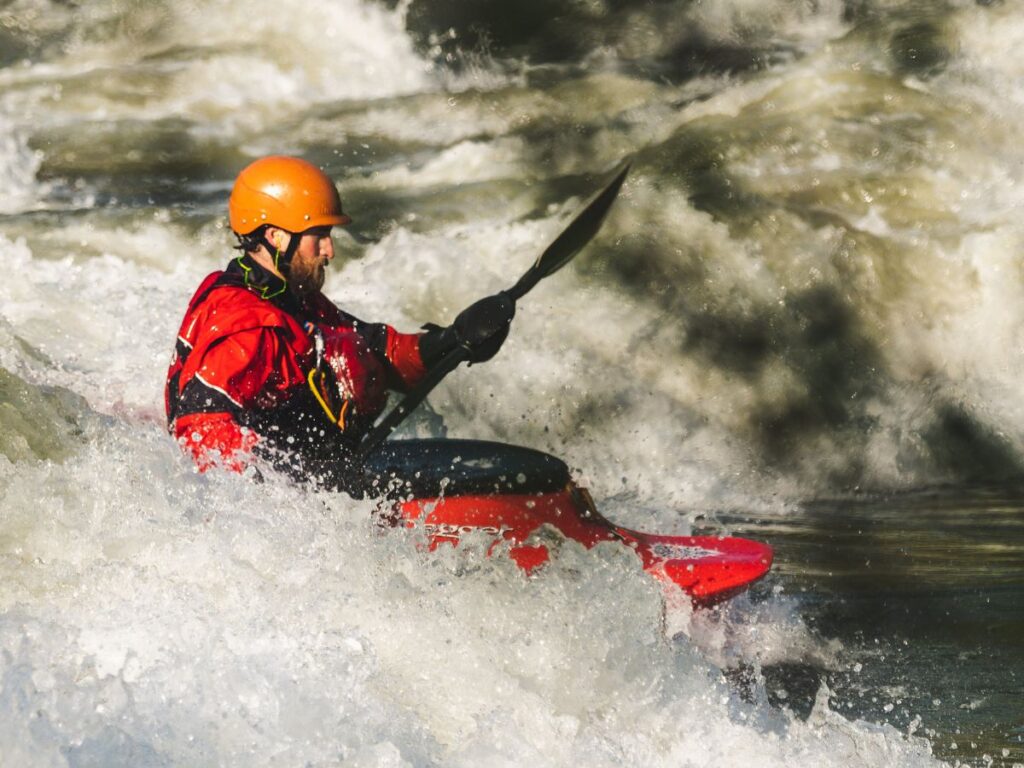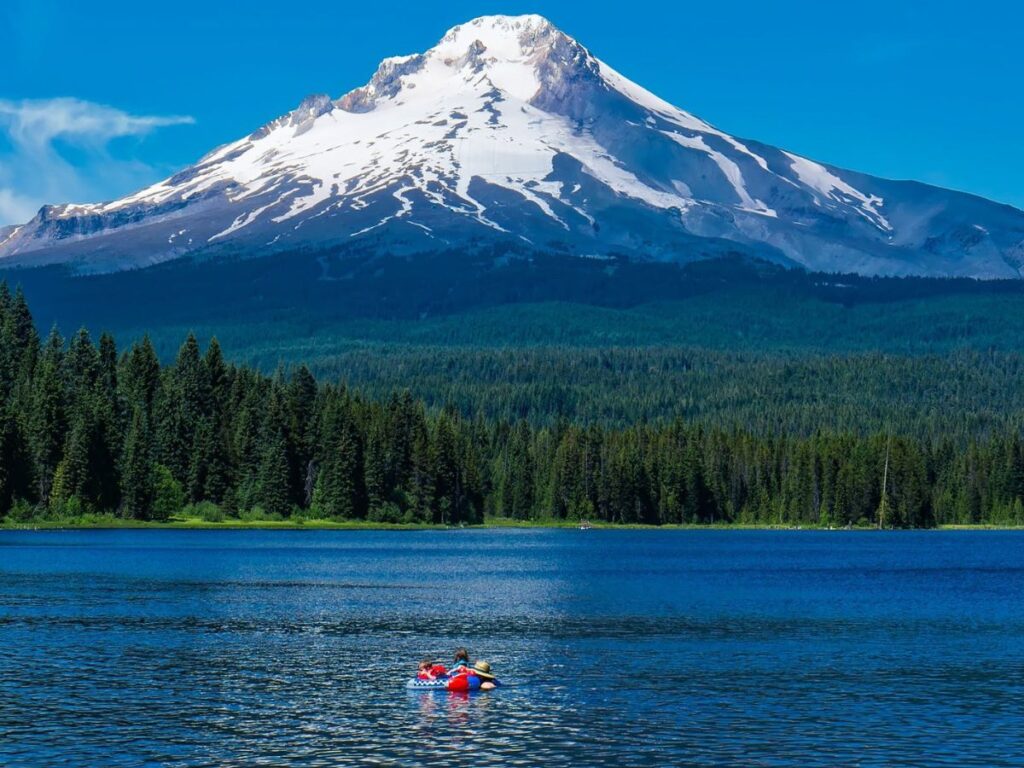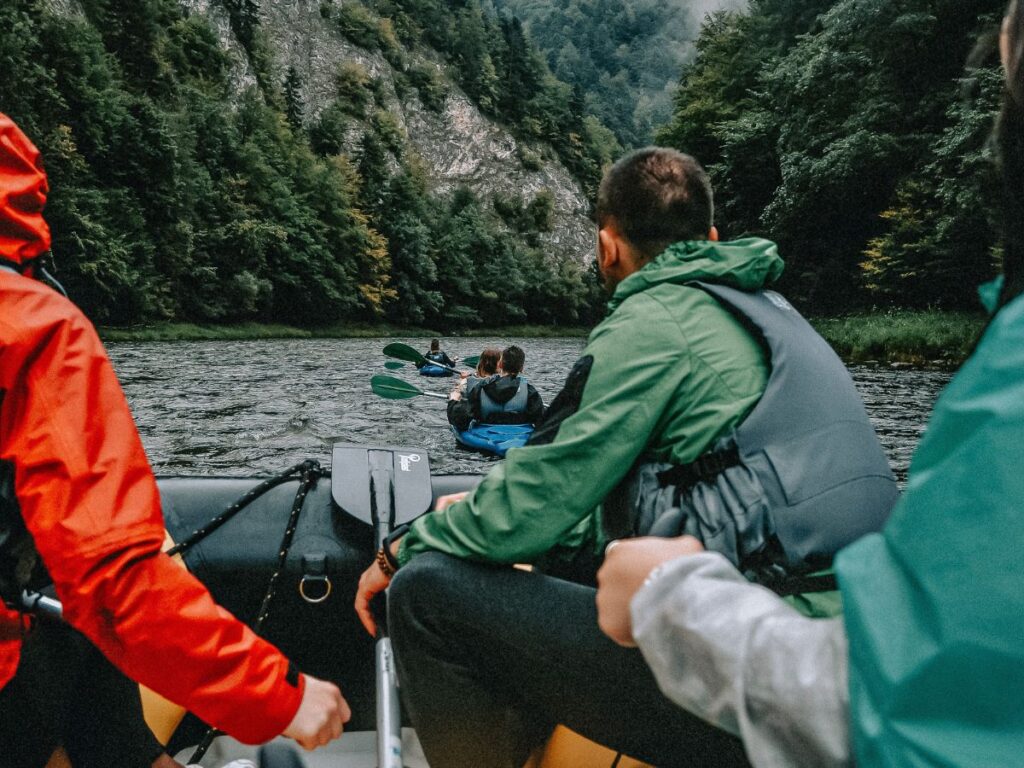Covering over 1,100 square miles of varied terrain, Yosemite dazzles with its sheer granite cliffs, plunging waterfalls, clear streams, and biological diversity.
Prepare to be swept away by the breathtaking beauty of Yosemite National Park as you embark on an epic rafting expedition. With towering cliffs, cascading waterfalls, and pristine wilderness as your backdrop, get ready for a thrilling and serene experience like no other. Discover the rush of conquering challenging rapids on the Merced River or indulge in a peaceful float along the tranquil Tuolumne River. In this comprehensive guide, uncover the best seasons to visit, essential practical information, and insider tips that will ensure your journey is nothing short of extraordinary.
Types & Locations of Rafting in Yosemite
Yosemite National Park, with its diverse waterways and stunning landscapes, offers a variety of rafting experiences. Depending on your thirst for adventure, you can pick from whitewater, scenic, or family rafting. Let’s dive in to explore each type in detail.
Whitewater Rafting
For thrill-seekers and adrenaline junkies, Whitewater Rafting in Yosemite offers the perfect blend of excitement and natural beauty. Navigating through the roaring rapids, you will experience the park like never before. If you’re in search of an adrenaline surge, look no further than whitewater rafting in Yosemite National Park.
As we navigate through Yosemite’s unique Whitewater rafting experiences, it’s time to spotlight the stunning locations that provide the backdrop for these unforgettable adventures:
Cherry Creek: Step into the heart of Yosemite with a thrilling rafting adventure down Cherry Creek. It’s the pinnacle of commercial rafting in the U.S, offering Class V rapids and a challenging experience. From the Holm Powerhouse starting point to the end at Merals Pool, you’ll cut through canyons and navigate exhilarating whitewater. This high-intensity experience, however, isn’t typically suitable for children.
Merced River: Imagine a full day on Class III-IV rapids, with towering cliffs and nature’s serenity all around you. That’s the Merced River experience. It starts from the Red Bud Picnic area and wraps up at Bagby Recreation Area, with the highest water levels in late spring and early summer. It’s an adventure that welcomes children aged 12 and above.
Tuolumne River: Mix the thrill of Class IV-V rapids with the stunning wilderness of Yosemite. The adventure begins at Meral’s Pool and concludes at Ward’s Ferry Bridge. This thrilling journey isn’t typically recommended for children due to its challenging nature.
South Fork Merced River: An offbeat track offering Class IV rapids amidst towering pines and granite formations. Beginning near Wawona and culminating at the Highway 140 Bridge, this experience is unique and exhilarating. Still, it’s generally not recommended for children due to its challenging rapids.
North Fork Tuolumne River: If you’re seeking Class V rapids and less crowded routes, this spot near Groveland is a great pick. You start near Groveland and end at the confluence with the Middle Fork Tuolumne River. This thrilling journey, however, isn’t suitable for children due to the challenging rapids.

Scenic Rafting
If a tranquil journey amidst Yosemite’s awe-inspiring landscapes is what you seek, Scenic Rafting is your go-to option. It allows you to leisurely explore the park’s waterways, taking in the sights and sounds at a relaxed pace. Yosemite’s Scenic rafting locations offer diverse landscapes and thrilling adventures. Let’s dive in to explore them.
Yosemite Valley: Picture yourself floating peacefully down the Merced River, with El Capitan and Yosemite Falls offering a stunning backdrop. Beginning and ending at Curry Village, this calm stretch is great for a leisurely ride and is family-friendly.
Tenaya Lake: Situated high above Yosemite Valley, Tenaya Lake offers breathtaking views and a serene rafting experience. Bring your raft, explore the lake’s perimeter and revel in its calm waters – it’s a spot suitable for children.
Mirror Lake: Enjoy a peaceful journey on this picturesque lake, surrounded by cliffs and trees that perfectly reflect in its calm waters. Although there are no rental services here, it’s an accessible and safe environment for children all year round, with the highest water levels during spring and early summer.
Hetchy Hetchy Reservoir: Glide along this reservoir, soaking in views of waterfalls and granite formations. Bring your own raft for this tranquil adventure that’s well-suited for children, particularly during late spring and early summer when water levels are at their peak.
Dana Fork Tuolumne River: Float leisurely along the Dana Fork, taking in the stunning views of towering peaks. This journey, starting from Tioga Pass Road and ending at Tuolumne Meadows Campground, is an idyllic experience for children, especially in late spring and early summer.
Family Rafting
Combining adventure with safety, Family Rafting in Yosemite is a fun-filled experience suitable for all ages. It offers the perfect opportunity for families to bond while gently navigating the park’s calmer waters. Let’s explore the destinations within the park where these adventures come to life:
Merced River in Yosemite Valley: Introduce your family to the joy of rafting on the gentle rapids of Merced River. Starting at Stoneman Bridge and finishing at Sentinel Beach Picnic Area, this journey is perfect for high water levels of late spring and early summer. With raft rentals and picnic spots available, it’s a family-friendly adventure.
Yosemite Valley: This peaceful float, beginning and ending at Curry Village, offers panoramic views of Yosemite’s iconic cliffs and waterfalls. This scenic rafting experience, particularly enjoyable during late spring when the water level is ideal, is suitable for all ages.
Wawona Swinging Bridge: For a gentle and fun-filled rafting experience, head to the South Fork Merced River at Wawona Swinging Bridge. The journey offers mild rapids and a serene natural setting that’s family-friendly and perfect for high water levels in late spring.
Tenaya Creek: This creek offers minimal rapids, making it an excellent spot for a family-friendly rafting experience. The journey begins at Tenaya Lake’s outlet and ends where Tenaya Creek meets the Mirror Lake trail. It’s an adventure that’s suitable for children, especially during the summer months.
Echo Creek: Seek tranquility in Yosemite’s high country with a peaceful journey down Echo Creek. Starting at Echo Lake and ending at the Echo Creek trailhead, this serene rafting experience amidst Yosemite’s natural beauty is great for families. Visit during early to mid-summer and don’t forget to bring your raft, it’s a spot that’s definitely child-friendly.
Best Seasons and Times for Rafting in Yosemite
Determining the best season and time for rafting in Yosemite can significantly enhance your experience. Let’s uncover the magic of the best season and find the perfect time for your unforgettable rafting adventure.
Best Rafting Season in Yosemite
The best season to go rafting in Yosemite is often considered to be late spring to early summer (May to June). Yosemite’s rafting season typically commences in April or May, extending until September. This period aligns with the melting of the snow from the Sierra Nevada, which significantly impacts the water levels in the rivers.
Moreover, during this time, the weather is generally warm and pleasant, which is ideal for outdoor activities like rafting. The landscapes are also particularly stunning in these months, with lush greenery and blooming wildflowers enhancing the scenic beauty of the rafting routes.
However, while late spring and early summer are the peak seasons, the choice of when to go rafting in Yosemite really depends on what kind of experience you are seeking. If you’re a novice rafter or you’re planning a family rafting trip with kids, late summer (July to September) could be the best time for you. During these months, the water levels recede, making the river calmer and more suitable for a leisurely, scenic rafting experience.
Optimal Times for Rafting
The optimal time of day for rafting in Yosemite varies based on personal preference. For those who enjoy tranquility and the allure of Yosemite’s stunning landscapes bathed in the soft, early light, morning rafting excursions are highly recommended. The park is often quieter at this time, allowing you to savor the experience more fully.
On the other hand, if you’re a fan of warmer temperatures and sun-soaked adventures, afternoon rafting is an excellent option. The vibrant afternoon sun amplifies the beauty of Yosemite’s landscapes, making for a truly memorable experience on the water. Regardless of the time you choose, each offers its unique charm and sets the stage for a fantastic rafting journey.

Seasonal Water Levels and Rafting Experiences
- Late Spring/ Early Summer: During this time, snowmelt from the Sierra Nevada results in high water levels. This leads to exciting, bigger rapids and a more challenging rafting experience. Ideal for thrill-seekers and experienced rafters.
- Mid-Summer: Water levels begin to recede, making the rapids less intense. The rafting experience during this period is more moderate, suited to intermediate rafters.
- Late Summer/ Early Fall: The water levels are lower and the river flows more gently. This offers a calm and scenic rafting experience, perfect for family outings and beginner rafters.
Weather Considerations for Rafting
- Check the local weather forecast before embarking on your rafting adventure.
- Sudden rain storms can significantly increase river levels and make conditions more challenging and potentially dangerous.
- Even if the weather appears clear at the start of your trip, be prepared for afternoon storms that can arise unexpectedly.
- Plan your rafting trip during periods of stable weather to minimize the risk of sudden changes in river conditions.
Practical Rafting Information
Pricing Information for Different Types of Rafting
Rafting prices in Yosemite can vary depending on the type of rafting experience you choose.
- Whitewater rafting: $100 to $200 per person
- Scenic rafting: $50 to $100 per person
- Family rafting: Similar pricing range as scenic rafting
How and Where to Purchase Tickets
To purchase rafting tickets in Yosemite, you have a few options. One option is to book directly with rafting companies or tour operators that operate within the park. They often have online booking systems where you can select your preferred date, time, and type of rafting experience. Another option is to visit the Yosemite Valley Visitor Center, where you can find information and purchase tickets in person.
Locations for Raft Rentals and Departure Points
If you’re looking to rent a raft, several locations in and around Yosemite offer this service. In Yosemite Valley, you can find raft rental options near Curry Village or Yosemite Village. These rental services provide you with the necessary equipment, including rafts, paddles, and life jackets. Additionally, certain tour operators or rafting companies may offer rental services as part of their guided trips.

Departure Points
As for departure points, they vary depending on the chosen rafting experience.
- Whitewater rafting on the Merced River: Starting points near Red Bud Picnic Area or designated spots along the river
- Scenic rafting in Yosemite Valley: Departure and finishing point at Curry Village
- Family rafting in Yosemite Valley: Departure points at locations such as Stoneman Bridge or Sentinel Beach Picnic Area
By considering the pricing options, purchasing tickets in advance, and knowing where to find raft rentals and departure points, you can make the practical aspects of your rafting experience in Yosemite more seamless, allowing you to focus on the adventure that lies ahead.
Restricted Areas for Rafting in Yosemite
While Yosemite National Park offers a vast playground for outdoor enthusiasts, there are certain areas where rafting is either off-limits or restricted. It’s important to be aware of these areas to ensure compliance with park regulations and to protect the park’s natural resources. Here are some key details:
Off-Limits Areas
Yosemite Valley Loop: Rafting is not permitted in the Yosemite Valley Loop, which includes Mirror Lake, Tenaya Creek, and the Merced River within the valley boundaries. These areas are reserved for scenic viewing and other recreational activities, but not for rafting.
Protected Wilderness Areas: Several designated wilderness areas within Yosemite, such as the Yosemite Wilderness and Ansel Adams Wilderness, do not allow rafting. These areas are protected to preserve their pristine nature and wildlife habitats.
Reasons for Restrictions
Preservation of Sensitive Ecosystems: Restricted areas often include sensitive ecosystems, such as meadows, wetlands, or critical wildlife habitats. Rafting is prohibited in these areas to minimize disturbance to the delicate balance of these ecosystems and protect vulnerable plant and animal species.
Preservation of Cultural & Historical Sites: Some restricted areas may encompass cultural or historical sites of significance, such as Native American cultural sites or historic structures. Rafting is prohibited in these areas to preserve their integrity and protect the rich cultural heritage of Yosemite.
Visitor Safety & Experience: Restrictions are also in place to ensure visitor safety and enhance the overall experience in Yosemite. By limiting rafting in certain areas, the park can manage visitor flow, reduce overcrowding, and mitigate potential conflicts between different recreational activities.
Things to Consider Before Going Rafting in Yosemite
Before embarking on your rafting adventure in Yosemite, there are several important factors to consider to ensure a safe and enjoyable experience. Here are some key aspects to keep in mind:
Rafting Experience & Skill Level: Assess your rafting experience and skill level honestly. Different sections of rivers in Yosemite vary in difficulty, so choose a route that matches your abilities. If you’re a beginner, opt for scenic or family rafting trips with calmer waters.
Water Conditions: Pay attention to current water conditions, such as flow rates and water levels. High water levels can result in faster currents and bigger rapids, which may require more advanced skills. Conversely, low water levels can affect navigation, potentially leading to shallow areas or exposed rocks.
Weather & Season: Check the weather forecast before your trip and be aware of any potential storms or heavy rainfall. Sudden weather changes can impact water levels and safety conditions. Consider the season and its effect on water temperatures and air temperatures to ensure appropriate gear and clothing.
Safety Equipment & Training: Always wear a properly fitted personal flotation device (PFD) or life jacket while on the water. It’s crucial to have a well-maintained raft and any necessary safety equipment, such as helmets, ropes, and rescue gear. Consider taking a rafting safety course or hiring a guide if you’re new to rafting or unfamiliar with the area.
Necessary Equipment and Gear
- A Personal Floating Device (PFD) is a vital piece of equipment that should be worn at all times while rafting. Ensure it is properly fitted and in good condition.
- Wear quick-drying clothing suitable for the weather conditions. Avoid cotton, as it can become heavy and uncomfortable when wet. Opt for synthetic or wool materials that provide insulation even when damp.
- Wear sturdy, closed-toe shoes that can handle wet conditions and offer good traction. Water shoes or sandals with straps are recommended to prevent them from getting lost in the water.
- Depending on the difficulty of the rafting route, additional protective gear such as helmets may be necessary. Check with the rafting company or tour operator to ensure you have the appropriate equipment.

Key Takeaways
- Yosemite offers diverse rafting experiences: whitewater, scenic, and family rafting.
- Top locations include Merced River, Tuolumne River, and South Fork.
- Best season: late spring for high water levels, late summer for calmer waters.
- Consider weather, water levels, and safety measures.
- Purchase tickets in advance or visit Yosemite Valley Visitor Center.
- Raft rentals near Curry Village and Yosemite Village.
- Safety: assess experience, wear PFD, check weather.
- Restricted areas: Yosemite Valley Loop, protected wilderness.
- Respect regulations, consult park authorities.
FAQs
1. Are there age restrictions for rafting in Yosemite?
Age restrictions vary, so check with the rafting company.
2. When is the best time to go rafting in Yosemite?
Late spring to early summer for higher water levels, late summer for calmer waters.
3. Can I bring my own raft for rafting in Yosemite?
Yes, but follow park regulations and safety guidelines.
4. Can I go rafting in Yosemite without experience?
Yes, beginner-friendly options are available.
5. Are there facilities along the rafting routes?
Facility availability varies, so check with the rafting company.
6. How long do rafting trips in Yosemite last?
Duration depends on the chosen route, so check with the company.
7. Can I rent necessary equipment for rafting?
Yes, many companies offer equipment rentals.
8. Can I book a private rafting tour in Yosemite?
Yes, private tour options are available.
9. Are food and drink options provided during rafting trips?
Food options may vary, so confirm with the tour operator.
10. What is the typical group size for guided rafting tours?
Group sizes can vary, so inquire with the tour operator.
